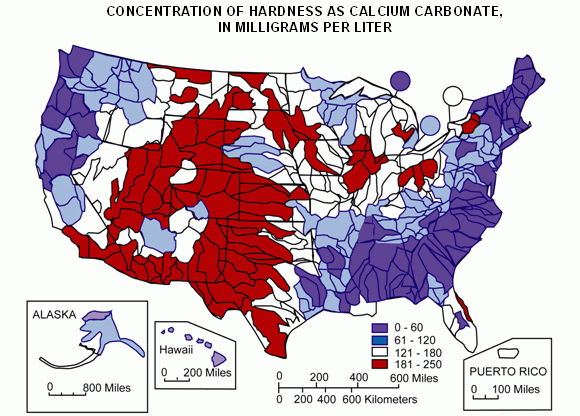There are times when a commercial ion exchange water softener is the preferred solution for hard water in potable water systems. The map above is from The United States Geological Survey (USGS) showing hardness expectations in the United States. Where would you use the ion exchange water softener instead of a Template Assisted Crystallization (TAC) water treatment? To find out, read more.
Ion Exchange Water Softeners vs. TAC Water Treatment
The ion exchange water softener is a technology many people are used to and requires having salts to soften the water. The ion exchange softener works by replacing the hard calcium and magnesium ions with the softer sodium ions. The TAC, or Template Assisted Crystallization, is a newer technology that transforms the hardness into harmless crystals. There is a clear advantage to the TAC technology. It adds no chemicals, uses no electricity, and wastes no water. That said, there is still a place for the traditional ion exchange softeners.
Where Should Ion Exchange be Used Instead of TAC?
There are limits to the Template Assisted Crystallization process. PVI and Lync by Watts suggest the TAC water treatment be limited to water with less than 30 grains of hardness. One grain is equal to 17.14 parts per million (ppm). The 30-grain limit is the same as about 514-ppm. That is miserably hard water, but it may exist in your area. An ion exchange softener would be a better option with hardness over thirty grains.
Another clear difference centers around the amount of iron and manganese in the water. Excessive amounts of these elements will cause reduced capacity or damage to both technologies. Some amounts of these elements in the water is acceptable. The WQ-SF ion exchange technology can withstand greater amounts than the Aquasolve TAC technology.
| Aquasolve TAC | WQ-SF Ion Exchange | |
| Iron (Max) | .3 mg/L | 1 mg/L |
| Manganese (Max) | .05 mg/L | 1 mg/L |
| Chlorine | 2 mg/L | 1 mg/L |
| Total Dissolved Solids (Max) | 1500 mg/L | 750 mg/L |
Both technologies recommend filters for all of the elements mentioned above for significant amounts. The chart will help you choose when there are lighter amounts. Water samples are suggested before deciding which technology is right for you.
The TAC technology should not be used as boiler feedwater or cooling tower makeup. There is a time limit to how long the crystals remain intact. After about 72 hours, the crystals will re-dissolve in the water and the hard ions will again be present. The tasteless crystals which are formed in the TAC process are normally simply sent down the drain in the potable water system. If we put them in a hydronic boiler, the water will be expected to be in system much more than 72 hours and the hardness will return. If we use the water as makeup in a steam boiler or cooling tower, the chemicals used in treatment will also affect the crystals.
There are other times when TAC may not be the first choice. One example is spotting on dishes or glassware. If TAC technology is used in the building, a point of use ion exchange softener may be appropriate for the commercial kitchen.
The times when you should specify ion exchange technology are clear:
- When the water hardness is over 30 grains.
- When there is more slightly iron and manganese in the water and it is not filtered out.
- When the water is used as makeup for boilers or cooling towers.
- When water is supplied to the commercial kitchen.
The Packaged Ion Exchange Solution
Lync® by Watts WQ-SF is a complete, fully engineered domestic water quality system solution. It is designed by one manufacturer for single, one contact responsibility. The WQ-SF is a compact, pre-assembled, and configurable sodium regenerated water softener for the reduction of water hardness.
The system utilizes an ion exchange resin to effectively remove hardness from the water by exchanging hardness ions such as calcium and magnesium for non-hardness ions such as sodium or potassium. When the resin has no more sodium or potassium to exchange for hardness minerals, the system will automatically regenerate, restoring its capacity to soften water.
WQ-SF includes mineral tanks to hold the ion exchange resin, a brine tank to hold the regeneration solution, and metered control valves for automatic operation of the system. The size of the mineral tanks is configurable based on the required flow rate of the system. The system solution is available in either Twin Alternating or Progressive Flow configurations.
Whether your water quality requires the template assisted crystallization (TAC) water conditioner or the ion exchange softener, call your R. L. Deppmann engineering sales rep or visit the Lync site for more information.



